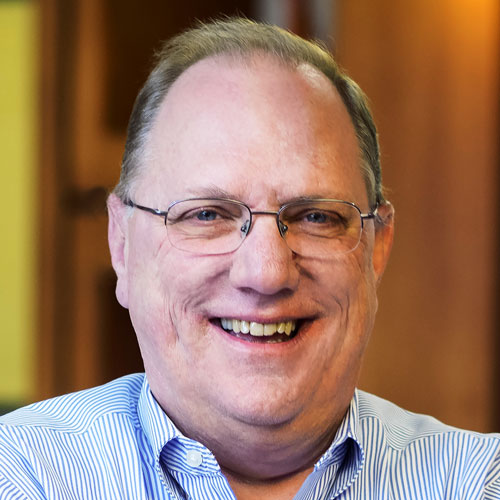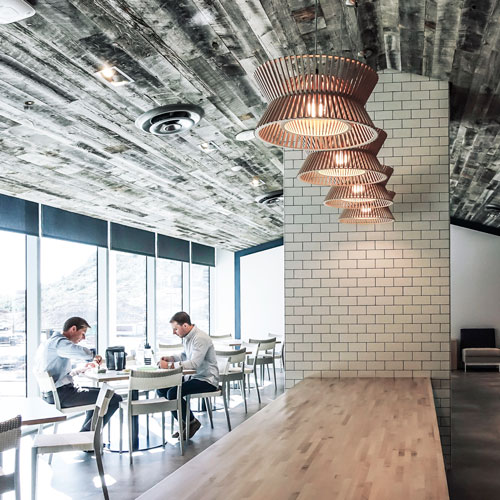In your mind’s eye, a bank may appear as though it has low-illuminated vaults lined with tiny, cramped compartments. But hopefully, that image doesn’t extend to the interior of the bank’s corporate headquarters. Nevertheless, only about a year ago, the phrase most frequently uttered by job candidates to describe the office aesthetic at Fifth Third Bank was “soul-sucking.”
“The spaces were very 1960s or 1970s—dated, dark, lacking in inspiration, and did not encourage collaboration. If you walked onto a floor, there was nothing to tell you that it was a Fifth Third environment. There were walled-off offices, a lot of cubicles with high partitions, and almost no natural light. It was almost like you were walking into a cave,” explains Donna Burnell, senior vice president and the managing director of enterprise workplace services.
But Burnell is now making waves at Fifth Third. And it’s not just a matter of her fluffing the décor or revamping the offices’ appearance, either. Instead, her and her team have reengineered the workday experience from the ground floor up.
“We’re moving away from that stale environment and want to encourage a sense of collaboration, sustainability, and wellness,” Burnell says.
Part of this is figuring out how to better utilize space in clever ways. “Study after study in a given industry reveals that at any point during the day, 30–40 percent of workstations are totally vacant,” Burnell says. “People may be meeting off-site with customers, attending group meetings, on vacation, sick, or just otherwise not there for some reason. I look at that as an underperforming asset, and when I see an underperforming asset, I want to turn that around and make it perform.”
The process includes designing workplaces made up of formal and informal collaborative areas. These spaces are complemented by a variety of workplace types and amenities, including workbenches, workstations, traditional offices, casual soft seating, presentation zones, cafés, and video conferencing to ensure connections to colleagues in other cities. Fifth Third even incorporates sit to stand desks and standing treadmill desks so that employees can get up and be active during the day while still being productive.
“Within any given floor area, there are types of spaces that an individual can go to lead what I call their self-curated day,” Burnell says. “If they need to make a private phone call, there are small telephone booths so that they can follow up on their children or medical appointments with confidentiality.”
Burnell and her team have also installed writable walls so that teams can brainstorm ideas as they arrive, collaborate, and keep the innovation flowing.
“We’re really equipping our teams with technology in addition to physical furniture,” she says. Before, offices were stocked almost exclusively with clunky desktop computers that lacked basic Wi-Fi capability. Now, employees’ mobile devices can seamlessly interact with new laptops through the network. They aren’t restricted to working in any one area of the building.
The workplace-services team also determined that staff used printers largely to compare and contrast multiple documents, so they implemented a system to make dual—or significantly larger—computer monitors more available.
“By being able to pull up both documents side by side, employees aren’t printing as much, and we’ve seen a significant reduction in our printing costs as well as our paper consumption,” Burnell says. “A strong financial company can only be strong if its community involvement and social responsibility are equally up to par, so we’re continuing to evolve into using sustainable products such as carpeting and looking at the supply chain to see how furniture is actually produced. We do a recycling program with a centralized depository. And when we construct, the old carpeting and furnishings don’t go to a landfill. We donate to charitable organizations our furniture that is in excess.” Another aspect of the sustainability initiative was the installation of refillable water-bottle stations in order to greatly reduce plastic waste.
Just as important as the health of the planet is the health of employees themselves, which is why Fifth Third has made efforts to dramatically enhance overall employee wellness. This has included providing access to healthy eating options and opening up the formerly windowless spaces to allow for more natural daylight.
“We want to create areas that can really energize the team,” Burnell explains. “I call it the right to light. Now, when the elevator doors open up onto one of our new environments, the first thing that hits you is that it’s bright. It’s reflective of our brand, and I
feel energized.”
For a bank such as Fifth Third, the initiative is also important because it attracts tech-savvy millennial talent and furthermore keeps the bank relevant in the face of major technology companies’ expansion into the financial sector through mobile payment platforms. For inspiration, Burnell finds herself turning toward Silicon Valley behemoths such as Apple, Google, and Cisco.
“I like to look at the world as a whole—as opposed to other financial institutions—for motivation in what we should do and not do,” Burnell says.
Among the challenges of implementing such a program in only about 15 months is the psychological element of coping with such a dramatic change. Many more-mature employees, she says, sometimes feel as though they’ve spent their entire careers in pursuit of that traditional walled corner office. As a result, Burnell’s department has directed energy into displaying the immense benefits of the new-gen office environment.
“The traditional challenges we’ve fortunately not had,” she says. “A lot of leaders at other institutions may like the concept but are equally quick to point out that it’s not a good fit for them or their team. The leadership at Fifth Third, however, really encourages support. They just get it. And that’s a fantastic catalyst for what we’re trying to do. It normally takes three to four years to stand something like this up, and we’ve been able to do it in less than a year.”
Another initiative Burnell is excited about is Fifth Third’s OurWorkplace program. “In addition to creating work environments that encourage collaboration, incorporate sustainability practices, energize our teams, and increase employee engagement, the designs also allow us to reduce occupancy expenses,” she says. “The cost savings from OurWorkplace are realized across multiple areas. Fewer offices and more flexible workspace options enable us to use the space more efficiently and reduce costs associated with traditional construction. Using modular furniture allows us to move these assets between spaces and reconfigure faster and cheaper when necessary. By using our existing space more efficiently, we can shed excess space and associated occupancy costs across
the footprint.”
Burnell’s knack for assessment and practical materialization of goals stems from her early formal training as a civil engineer. After working on behalf of the Canadian federal government on projects such as schools, houses, and hospitals in the harsh weather conditions of the far north, she was tapped for the project team for the 1988 Calgary Winter Olympics. She then joined CIBC bank, where she was responsible for the strategic real estate and capital planning. This led to a series of roles supporting Bank of America and Wachovia/Wells Fargo, where she managed retail properties. In March 2016, she joined Fifth Third.
“My time at Fifth Third is really going to be the culmination of my career,” Burnell says. “I’m so excited just to be here. After 15 months, I feel like I’ve just walked in the door and am still just as excited. It’s inspirational what leadership has done on my behalf to support my team in this. All that said, I’m trying to create environments where people want to come into work and be there and be inspired. You can’t innovate in a vacuum.”
***
CBRE is proud to partner with Donna Burnell and Fifth Third Enterprise Workplace Services, and we congratulate her on this recognition for her innovative, tireless, inspiring leadership. In an uncertain industry, Donna is preparing her team to be nimble, efficient, and extremely customer-focused. And all the while, she makes it fun!


